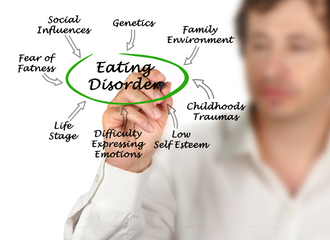Written by: Angela Kaloudis, LMHC, PMH-C, NCC
Clinical Training Specialist at The Renfrew Center
 Eating disorders affect all kinds of people, from all types of backgrounds. The problem is treatment practitioners don’t always know how to acknowledge or accommodate this truth. Here’s how to fix that.
Eating disorders affect all kinds of people, from all types of backgrounds. The problem is treatment practitioners don’t always know how to acknowledge or accommodate this truth. Here’s how to fix that.
Many populations who are impacted by eating disorders go undetected and undiagnosed. Most people with eating disorders are often overlooked by healthcare professionals simply due to not fitting the stereotype. Perhaps surprisingly, those who treat eating disorders have similar levels of weight bias as other healthcare providers and this bias keeps people from obtaining a needed diagnosis for accurate and adequate treatment.
What Research Says About Eating Disorder Demographics
People continue to believe that majority of eating disorders affect young, white, affluent women. However, research shows that eating disorders impact people within all domains of diversity: all races, sizes, ages, abilities, and socioeconomic status and that incidence rates of eating disorders are often the same if not more in these populations. (Swanson, 2011; Goeree, Sovinsky, & Iorio, 2011; Strother, E., 2011). It benefits everyone when people see themselves in the room, reflected in the examples used, and in the media (i.e., photos and video clips).
Why Inclusivity Matters
The more othered someone feels, the more marginalized someone is. The more recovery feels unattainable, the more a feeling that it is safe enough to be vulnerable decreases. When thinking about the experience of having a body and being in it, these experiences are vastly different for those who do not fit the societal view of who has an eating disorder.
Inclusivity improves:
- Client engagement, therefore increasing opportunity to reach full recovery
- Body Image distress
- Self-efficacy and self-worth
- Less reliance on ED behaviors due to connectedness increasing
- Connection and community due to feeling seen and heard therefore creating safety
How Practitioners Can Be More Inclusive
So, what does this mean for eating disorder treatment providers and practitioners? How can you ensure your approach to treatment acknowledges and accommodates a wider, more inclusive range of people? Here’s where to start.
- Acknowledge your perspective: Even as clinicians we are prone to bias.
- Explore biases: Know that internal biases also exist within the groups themselves (ex: external and internal weight stigma can exist even among those who experience it).
- Understand people as unique individuals: And also within the context of being a member of an oppressed group.
- Study their emotional experience: Explore emotions about their experience, along with perceptions about how others experience them.
- Get a sense of their community: Examine the extent to which one has acquired connections within their community.
- Appreciate their social experience: Keep in mind that patients often hold multiple intersectionalities and being inclusive of all helps everyone.
- Appreciate how they navigate it: Identify the strengths and coping skills in negotiating the ‘two worlds’ they live in & reinforce personal strengths.
- Pay attention to their resilience: Examine those parts of self which are responding resourcefully to forces both within and without their control.
Trauma-Informed Treatment: Preventing Bias from Undermining Your Approach
Unexamined bias and eating disorder treatment not being inclusive can retraumatize and cause undue and avoidable stress to a person’s nervous system. At the core, the very best practice to being inclusive is best attained by trauma-informed treatment. For most people with eating disorders, being othered and marginalized is not a unique experience and trauma-informed care (TIC) acknowledges we need to have a complete picture of a patient’s life situation — past and present — in order to provide effective treatment with a healing orientation.
Trauma-informed care seeks to:
- Realize the widespread impact of trauma
- Recognize the signs and symptoms of trauma in patients, families, and staff;
- Integrate knowledge about trauma into policies, procedures, and practices; and
- Actively avoid re-traumatization.
(Adapted from the Substance Abuse and Mental Health Services Administration’s “Trauma-Informed Approach.”)
Below are SAMHSA’s six key guiding principles of a trauma-informed care approach. Whether you are in an organization or working as a sole-practitioner, we all can take steps to be more trauma-informed by using these same principles for ourselves and our patients.
- Safety: Feeling physically and psychologically safe the office/environment
- Trustworthiness and transparency: Decisions (i.e. treatment plans) are made with transparency, and with the goal of building and maintaining trust
- Peer support: Individuals with shared experiences are integrated into the organization and viewed as integral to service delivery
- Collaboration and mutuality: Power differences — between staff and clients and among organizational staff — are leveled to support shared decision-making
- Empowerment, voice, and choice: Patients are met with openness and choice in their treatment, strengths are recognized, built on, and validated — this includes a belief in resilience and the ability to heal and recover from their eating disorder
- Cultural, historical, and gender issues: Biases and stereotypes (e.g., based on race, weight, ability, ethnicity, sexual orientation, age, gender, socioeconomic status) and historical trauma are recognized and addressed
Conclusion: Incorporating Trauma-Informed Treatment Into Your Practice
Within the eating disorder sector, there are several important ways to be more trauma-informed in your practice.
- Have seats that fit all bodies (not just a few options for seating, but if possible, all seats should fit all bodies).
- Keep in mind your own bias in the examples you use and the way you discuss body image
- Body image work not just focused on body positivity
- Make sure chairs do not have arms
- Be collaborative with your treatment plans and reduce surprise
- Make sure all ramps and doorways are up to code
- If an elevator is used, create a plan if the elevator isn’t working
All eating disorder treatment must be inclusive and trauma-informed in order for recovery to be sustainable and free of harm. Inclusivity is achieved by clinicians, teachers, and other professionals paying more attention to eating disorders that push against the common paradigm.



